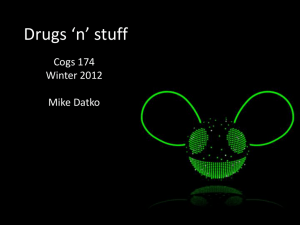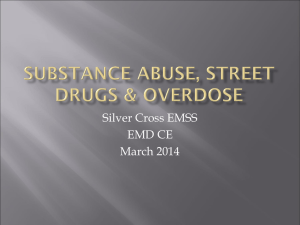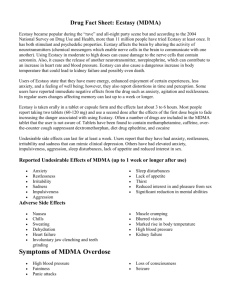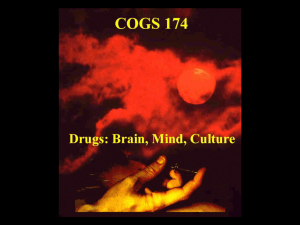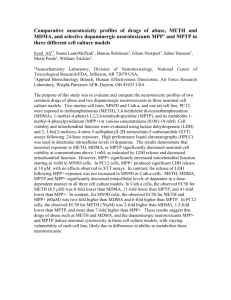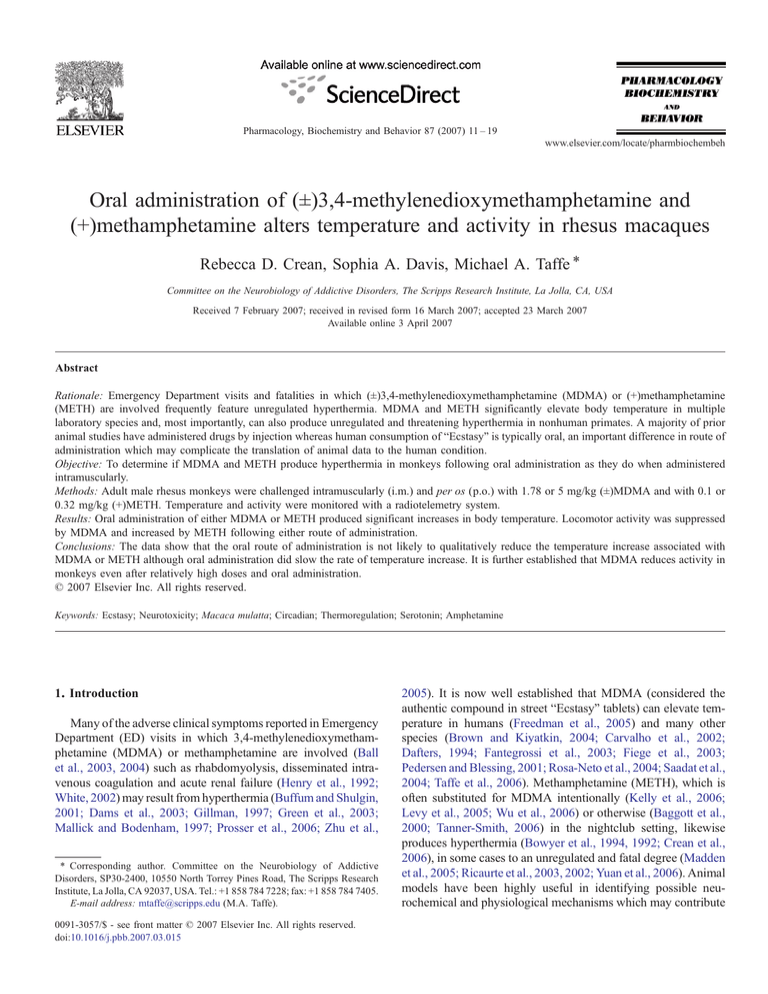
Pharmacology, Biochemistry and Behavior 87 (2007) 11 – 19
www.elsevier.com/locate/pharmbiochembeh
Oral administration of (±)3,4-methylenedioxymethamphetamine and
(+)methamphetamine alters temperature and activity in rhesus macaques
Rebecca D. Crean, Sophia A. Davis, Michael A. Taffe ⁎
Committee on the Neurobiology of Addictive Disorders, The Scripps Research Institute, La Jolla, CA, USA
Received 7 February 2007; received in revised form 16 March 2007; accepted 23 March 2007
Available online 3 April 2007
Abstract
Rationale: Emergency Department visits and fatalities in which (±)3,4-methylenedioxymethamphetamine (MDMA) or (+)methamphetamine
(METH) are involved frequently feature unregulated hyperthermia. MDMA and METH significantly elevate body temperature in multiple
laboratory species and, most importantly, can also produce unregulated and threatening hyperthermia in nonhuman primates. A majority of prior
animal studies have administered drugs by injection whereas human consumption of “Ecstasy” is typically oral, an important difference in route of
administration which may complicate the translation of animal data to the human condition.
Objective: To determine if MDMA and METH produce hyperthermia in monkeys following oral administration as they do when administered
intramuscularly.
Methods: Adult male rhesus monkeys were challenged intramuscularly (i.m.) and per os (p.o.) with 1.78 or 5 mg/kg (±)MDMA and with 0.1 or
0.32 mg/kg (+)METH. Temperature and activity were monitored with a radiotelemetry system.
Results: Oral administration of either MDMA or METH produced significant increases in body temperature. Locomotor activity was suppressed
by MDMA and increased by METH following either route of administration.
Conclusions: The data show that the oral route of administration is not likely to qualitatively reduce the temperature increase associated with
MDMA or METH although oral administration did slow the rate of temperature increase. It is further established that MDMA reduces activity in
monkeys even after relatively high doses and oral administration.
© 2007 Elsevier Inc. All rights reserved.
Keywords: Ecstasy; Neurotoxicity; Macaca mulatta; Circadian; Thermoregulation; Serotonin; Amphetamine
1. Introduction
Many of the adverse clinical symptoms reported in Emergency
Department (ED) visits in which 3,4-methylenedioxymethamphetamine (MDMA) or methamphetamine are involved (Ball
et al., 2003, 2004) such as rhabdomyolysis, disseminated intravenous coagulation and acute renal failure (Henry et al., 1992;
White, 2002) may result from hyperthermia (Buffum and Shulgin,
2001; Dams et al., 2003; Gillman, 1997; Green et al., 2003;
Mallick and Bodenham, 1997; Prosser et al., 2006; Zhu et al.,
⁎ Corresponding author. Committee on the Neurobiology of Addictive
Disorders, SP30-2400, 10550 North Torrey Pines Road, The Scripps Research
Institute, La Jolla, CA 92037, USA. Tel.: +1 858 784 7228; fax: +1 858 784 7405.
E-mail address: mtaffe@scripps.edu (M.A. Taffe).
0091-3057/$ - see front matter © 2007 Elsevier Inc. All rights reserved.
doi:10.1016/j.pbb.2007.03.015
2005). It is now well established that MDMA (considered the
authentic compound in street “Ecstasy” tablets) can elevate temperature in humans (Freedman et al., 2005) and many other
species (Brown and Kiyatkin, 2004; Carvalho et al., 2002;
Dafters, 1994; Fantegrossi et al., 2003; Fiege et al., 2003;
Pedersen and Blessing, 2001; Rosa-Neto et al., 2004; Saadat et al.,
2004; Taffe et al., 2006). Methamphetamine (METH), which is
often substituted for MDMA intentionally (Kelly et al., 2006;
Levy et al., 2005; Wu et al., 2006) or otherwise (Baggott et al.,
2000; Tanner-Smith, 2006) in the nightclub setting, likewise
produces hyperthermia (Bowyer et al., 1994, 1992; Crean et al.,
2006), in some cases to an unregulated and fatal degree (Madden
et al., 2005; Ricaurte et al., 2003, 2002; Yuan et al., 2006). Animal
models have been highly useful in identifying possible neurochemical and physiological mechanisms which may contribute
12
R.D. Crean et al. / Pharmacology, Biochemistry and Behavior 87 (2007) 11–19
to unregulated hyperthermia (see Green et al., 2004; Rusyniak and
Sprague, 2005, for review). One question which has not been
explored to a significant extent is the influence of the route of drug
administration on thermoregulatory responses to MDMA. This
is potentially a critical issue since Ecstasy is overwhelmingly
consumed orally by human users; one recent survey confirms that
only about 8% of regular Ecstasy users have injected Ecstasy in
the past 6 months (White et al., 2006). In contrast MDMA, METH
and other amphetamines have been administered by intramuscular, subcutaneous or intraperitoneal injection in most animal
studies.
Studies on the risks posed by orally administered MDMA are
also increasingly important because of proposed therapeutic applications. For example trials have recently been planned or
initiated in the US, Switzerland and Israel to use MDMA in the
treatment of Post-Traumatic Stress Disorder and for anxiety in late
stage cancer (Doblin, 2006; Mithoefer, 2006a; Mojeiko, 2006;
Oehen, 2006). Furthermore, some recent findings from animal
models suggest that MDMA may be therapeutically useful in
Parkinson's Disease (Bishop et al., 2006; Iravani et al., 2003;
Sotnikova et al., 2005) thereby increasing the potential for additional human trials and eventual clinical use of MDMA. Other
amphetamines are already in current clinical use, for example
METH is marketed as Desoxyn® for indications such as ADHD
and obesity. The METH metabolite (+)amphetamine (which
produces subjective and physiological effects in humans and
other species that are highly similar to METH) is marketed for
ADHD therapy (Adderall®). Perhaps unsurprisingly, amphetamines formulated for oral therapeutic use are frequently diverted
for recreational use (McCabe et al., 2006, 2004; Upadhyaya et al.,
2005; Wilens et al., 2006; Wu et al., in press).
Recent studies have shown that rhesus monkeys develop elevated temperature after intramuscular administration of racemic
MDMA or either enantiomer (Taffe et al., 2006) and that the
magnitude of the effect is invariant across ambient temperatures
from 18 to 30 °C (Von Huben et al., 2007). In contrast rodent
temperature responses are highly sensitive to ambient temperature
and enantiomer (Fantegrossi et al., 2003; Malberg and Seiden,
1998). Interestingly, MDMA appears to produce a greater magnitude of peak hyperthermia in rats in comparison with METH
administered at an equal dose (Clemens et al., 2005, 2004)
whereas METH produces a similar peak temperature response in
monkeys at equivalent or slightly lower doses compared with
MDMA (Crean et al., 2006). Such observations suggest that
monkey thermoregulatory responses to amphetamines may differ
somewhat from rodents and at least in the case of ambient temperature be more similar to human responses (Freedman et al.,
2005). It therefore continues to be important to examine thermoregulatory responses to MDMA in nonhuman primate models.
The present study was conducted to determine if the acute
thermoregulatory effects of MDMA and METH in rhesus monkeys are qualitatively different when administered orally or by
intramuscular injection. Although primarily motivated to explore thermoregulatory risks associated with recreational consumption of these compounds, the studies also contribute to
understanding risks associated with current and proposed medical use of METH and MDMA.
2. Materials and methods
2.1. Animals
Ten individually housed male rhesus monkeys (Macaca
mulatta) were used in these experiments. Animals were 6–
10 years of age, weighed 8.5–15 kg at the start of the study and
exhibited body condition scores (Clingerman and Summers,
2005) of 2.0–3.75 out of 5 at the nearest quarterly exam. Daily
chow (160–248 g; LabDiet® 5038, PMI Nutrition International,
Richmond, IN, USA; 3.22 kcal of metabolizable energy (ME)
per gram) allocations were determined by a power function
(Taffe, 2004a,b) fit to data provided in a National Research
Council recommendation (NRC/NAS, 2003) and modified
individually by the veterinary weight management plan. The
animals' normal diet was supplemented with fruit or vegetables
7 days per week and water was available ad libitum in the home
cage at all times. Animals on this study had previously been
immobilized with ketamine (5–20 mg/kg) no less than semiannually for purposes of routine care and some experimental procedures. Animals also had various acute exposure to
raclopride, SCH23390 (Von Huben et al., 2006), methylphenidate, Δ9-THC, nicotine, mecamylamine (Katner et al., 2004a)
and scopolamine in behavioral pharmacological studies and 4
had been exposed to an oral ethanol induction procedure (Katner
et al., 2004b). Experimental drug treatments had been last
administered a minimum of 1 year prior to the start of thermoregulation studies. These animals had been participating in
temperature/activity studies related to this one and had received
prior doses of delta9-tetrahydrocannabinol (0.1–0.3 mg/kg),
MDMA (0.56–5 mg/kg), METH (0.1–1 mg/kg) and/or 3,4methylenedioxyamphetamine (0.56–5 mg/kg) in acute studies
no more frequently than once per week. The precise history
of each animal was not identical but was highly similar within
groups of six (Crean et al., 2006) and four monkeys (Taffe
et al., 2006). The United States National Institutes of Health
guidelines for laboratory animal care (Clark et al., 1996) were
followed and all protocols were approved by the Institutional
Animal Care and Use Committee of The Scripps Research Institute (La Jolla).
2.2. Apparatus
Radio telemetric transmitters (TA10TA-D70; Transoma/Data
Sciences International, St. Paul, MN, USA) were implanted
subcutaneously in the flank. The surgical protocol was adapted
from the manufacturer's surgical manual and implantation was
conducted by, or under supervision of, the TSRI veterinary staff
using sterile techniques under isoflurane anesthesia. Temperature and gross locomotor activity recordings were obtained from
the transmitters implanted in the monkeys via in-cage receivers
(RMC-1; Transoma/Data Sciences International, St. Paul, MN,
USA). Data were recorded on a 5 min sample interval basis by
the controlling computer and represented as a moving average
of three samples (− 5 min, current, +5 min) for each 10 min.
Ambient room temperature was also recorded by the system via
a probe mounted near the top of the housing room.
R.D. Crean et al. / Pharmacology, Biochemistry and Behavior 87 (2007) 11–19
2.3. Drug challenge studies
For these studies doses of (±)3,4-methylenedioxymethamphetamine HCl (1.78, 5 mg/kg) or (+)methamphetamine HCl
(0.1, 0.32 mg/kg) were administered intramuscularly (i.m.) in a
volume of 0.1 ml/kg saline and per os (p.o.) in a volume of 1–
2 ml/kg. Oral administration was conducted by training animals
to drink flavored vehicle solutions (Tang®, KoolAid®, etc.)
from a 10 ml syringe. Drugs were provided by the National
Institute on Drug Abuse (Bethesda, MD, USA). All challenges
were administered in the middle of the light cycle, either at 1030
or 1300 h, with active doses separated by not less than 1 week.
The ambient room temperature averaged 23–27 °C for these
studies. The intramuscular 1.78 mg/kg MDMA and intramuscular METH data (and respective i.m. vehicles) were reported
previously (Crean et al., 2006) and are employed here as a
comparison with the p.o. data. The 5 mg/kg MDMA i.m. and p.o.
challenges were conducted in the original group of six subjects
used in Crean et al. (2006), however the remaining p.o. studies
were subsequently conducted with 5 of this original group due to
transmitter battery expiration in one of the original six animals.
The ongoing studies, including the present, were conducted over
an interval of about 5–14 months in a given monkey. In general,
the 5 mg/kg MDMA studies were conducted within a month
of the conclusion of the intramuscular studies (which were
conducted over about 5 months) and the oral studies were
initiated about 2 months later. For each active drug challenge the
relevant vehicle data were collected within about 3 weeks of the
active dose day. The rectal/telemetry comparison was conducted
in a different group of 4 animals which participated in an earlier
study (Taffe et al., 2006). Rectal temperatures were recorded
under ketamine immobilization (10 mg/kg) with the probe inserted ∼ 5 cm.
13
data as changes from baseline within individual as the most
intuitive representation of both the dosing and analytic (i.e.,
repeated measures) designs. The statistical analysis of activity
was similar to that for temperature except the time factor used 1 h
bins for total activity counts. Post-hoc analyses of all significant
effects were conducted with the Fisher's LSD procedure. All
statistical analyses were conducted using GB-STAT v7.0 for
Windows (Dynamic Microsystems, Inc., Silver Spring MD) and
the criterion for significance in all tests was p b 0.05.
3. Results
3.1. Temperature effects of MDMA
MDMA significantly increased body temperature following
either oral (per os; p.o.) or intramuscular (i.m.) routes of administration and at either dose (Figs. 1 and 2). A significant
increase in temperature (Fig. 1) was observed after 1.78 mg/kg
MDMA as was confirmed by a significant main effect of drug
treatment condition [F1,5 = 7.47; p b 0.05] and of time post-
2.4. Data analysis
Randomized block (repeated measures) analysis of variance
(ANOVA) was employed to evaluate acute treatment-related
effects on temperature and activity. In general, two repeated
measures factors were included to determine the effects of drug
treatment condition and time relative to drug administration. The
analyses were designed based on results from our prior studies.
The temperature analysis for the lower dose MDMA challenges
started 10 min prior to injection (referred to as “baseline”) and
continued for 2 h post-injection (sample “+ 120 min”). This
interval was designed into the study as the interval in which
normal, potentially disruptive, daily room activities were suspended, similar to our prior MDMA studies (Crean et al., 2006;
Taffe et al., 2006; Von Huben et al., 2007), because original pilot
work suggested this was the duration of acute MDMA effects at
this dose. Analysis of the 5 mg/kg MDMA and oral METH data
was extended to 300 min after dosing to permit a more direct
comparison with our prior study (Crean et al., 2006) in which the
acute temperature changes lasted at least 5 h after intramuscular
METH administration. Analysis was limited to 5 h after dosing
as this was the shortest interval between dosing and the beginning of the dark period. The figures represent the temperature
Fig. 1. Mean (N = 5–6, bars indicate SEM) temperature for animals treated with
1.78 mg/kg MDMA per os (upper panels) or intramuscularly (lower panels).
Temperature data are represented as changes from the average of three samples
prior to administration for each animal to appropriately reflect the repeated
measures analysis of the absolute temperature data. The break in each series
indicates the time of injection; the slight change in temperature at time “0” in part
reflects variation in administration to all 6 subjects relative to the computer sampling schedule and the moving average procedure, see Materials and methods. The
intramuscular data were previously reported (Crean et al., 2006) and are reused
with permission from Elsevier. The open symbols indicate a significant difference
from both baseline (the sample immediately prior to drug administration) and the
respective vehicle condition and the ⁎ indicates a significant difference from the
baseline (only).
14
R.D. Crean et al. / Pharmacology, Biochemistry and Behavior 87 (2007) 11–19
Fig. 2. Mean (N = 6, bars indicate SEM) temperature for animals treated with
5.0 mg/kg MDMA per os or intramuscularly. Temperature data are represented as
changes from the average of three samples prior to administration for each animal
to appropriately reflect the repeated measures analysis of the absolute temperature data. The open symbols indicate a significant difference from both
baseline (the sample immediately prior to drug administration) and the respective
vehicle condition and shaded symbols indicate a significant difference from the
vehicle condition at a given timepoint (only). A significant difference between
MDMA administered i.m. and p.o. is indicated by #.
administration [F13,65 = 13.19; p b 0.0001]. The post-hoc test
confirmed that after 1.78 mg/kg MDMA p.o., temperature was
significantly elevated over baseline (10–120 min post-administration) and over the oral vehicle condition (20–40, 60–
120 min). The post-hoc test also confirmed that temperature
was significantly elevated over baseline after i.m. injection of
1.78 mg/kg MDMA (0–50 min). Temperature was also significantly elevated over baseline after i.m. vehicle injection
(10–60 min) however did not differ significantly between i.m.
vehicle and i.m. drug at any timepoint. Post-hoc analysis also
confirmed a significant difference in temperature between i.m.
and p.o. vehicle treatments and between i.m. and p.o. 1.78 mg/kg
MDMA conditions for most timepoints; temperature was consistently higher by about 0.2 °C.
The 5 mg/kg dose of MDMA also significantly increased temperature (Fig. 2; significant main effects of drug treatment condition [F3,15 = 3.68; p b 0.05], time post-administration [F31,155 =
6.44; p b 0.0001] and an interaction of factors [F93,465 =3.38; p b
0.0001]). The post-hoc test confirmed that temperature was
significantly elevated over baseline from 10 to 270 min after i.m.
injection and from 20 to 280 min after p.o. administration.
Temperature was also elevated over baseline 110–120 min after
vehicle, i.m. Similarly, 5 mg/kg MDMA elevated temperature
relative to the respective vehicle control condition after i.m. (10–
280 min) and p.o. (10–300 min) administration. Finally, temperature was significantly different between 5 mg/kg MDMA i.m.
and p.o. conditions 20–50 min after administration thus indicating
a slowed rate of increase associated with oral administration.
3.2. Temperature effects of METH
The administration of METH by oral or intramuscular routes
of administration significantly increased temperature (Fig. 3;
significant main effects of drug condition [F2,10 = 42.13; p b
0.0001] and time post-administration [F31,155 = 10.72; p b0.0001]
as well as the interactions between route of administration
and time post-administration [F31,155 = 5.01; p b 0.0001] and between drug condition and time post-administration [F62,310 = 4.47;
p b 0.0001]). The post-hoc test confirmed that temperature was
significantly elevated from baseline after 0.1 mg/kg METH,
p.o. (30–300 min post-administration) and after 0.32 mg/kg
METH, p.o. (30–300 min), but not after oral vehicle. Temperature was also significantly elevated relative to oral vehicle after
0.1 mg/kg METH, p.o. (40–300 min post-administration) and
after 0.32 mg/kg METH, p.o. (30–300 min). The post-hoc evaluation further confirmed that temperature was elevated over
baseline by the intramuscular vehicle (10–100 min post-administration), 0.1 mg/kg METH, i.m. (10–220 min post-administration) and by 0.32 mg/kg METH, i.m. (10–290 min). Furthermore,
temperature was elevated relative to the intramuscular vehicle
condition after 0.1 mg/kg METH, i.m. (60–230, 270–300 min
post-administration) and by 0.32 mg/kg METH, i.m. (all
timepoints).
Temperature both increased and decreased more quickly
after i.m. injection of either dose of METH relative to p.o.
administration. The post-hoc test confirmed that temperature
was both significantly higher (10–20 min) and lower (130,
200–290 min) after 0.1 mg/kg METH i.m., relative to the same
Fig. 3. Mean (N = 5–6, bars indicate SEM) temperature values for animals treated
with 0.1 or 0.32 mg/kg METH per os or intramuscularly are presented. Temperature data are represented as changes from the average of three samples prior to
administration for each animal to appropriately reflect the repeated measures
analysis of the absolute temperature data. The intramuscular data were previously
reported (Crean et al., 2006) and are reused with permission from Elsevier. The
open symbols indicate a significant difference from both baseline (the sample
immediately prior to drug administration) and the respective vehicle condition. The
⁎ indicates a significant difference from the baseline (only) and a significant
difference between METH administered i.m. and p.o. is indicated by #.
R.D. Crean et al. / Pharmacology, Biochemistry and Behavior 87 (2007) 11–19
15
dose p.o. Similarly, temperature was higher (10–30 min) and
lower (60, 160–300 min) after 0.32 mg/kg METH i.m. relative
to the same dose p.o. No significant differences in temperature
between the oral and the i.m. vehicles were confirmed.
3.3. Activity effects of MDMA and METH
Activity was significantly changed after the administration
of 1.78 mg/kg MDMA (effects of the interaction of drug condition with time post-administration [F5,25 = 3.06; p b 0.05] and the
interaction of all factors [F5,25 = 3.74; p b 0.05]) as is shown in
Fig. 4A. Post-hoc evaluation confirmed that activity was lower
than baseline (the hour preceding administration) and the respective vehicle timepoint in the first hour after 1.78 mg/kg
MDMA i.m. In addition, activity was lower 1–2 h after 1.78 mg/kg
MDMA i.m. and 1 h after i.m. vehicle in comparison with the
activity after the same treatments administered p.o. Thus the low
dose of MDMA initially decreased activity after i.m., but not after
oral, administration. Activity was also lower than the baseline 5 h
(p.o.) and 2–5 h (i.m.) after vehicle consistent with typical
circadian changes across the day under normal circumstances.
Activity was also significantly decreased (Fig. 4B) after the
administration of 5 mg/kg MDMA (main effects of route of
administration [F1,5 = 21.34; p b 0.01]; drug treatment condition
[F1,5 = 8.17; p b 0.05], time post-administration [F5,25 = 2.88; p b
0.05] and the interaction of drug condition with time [F5,25 =
5.93; p b 0.001]). The post-hoc test confirmed that activity was
significantly lower after 5 mg/kg MDMA in comparison with
both the pre-treatment baseline and the respective vehicle
timepoint 1–2 h after i.m. administration and in the second hour
after p.o. administration. In total, activity was significantly lower
than the baseline for intervals 1–5 h after 5 mg/kg MDMA i.m.
and from 2 to 5 h after p.o. administration. Activity was never
significantly different from baseline after the i.m. vehicle and
was lower than baseline only 4–5 h after p.o. vehicle. Finally,
activity was lower 1, 2 and 4 h after i.m. administration of 5 mg/
kg MDMA in comparison with similar timepoints after p.o.
administration. Thus activity was significantly reduced by 5 mg/
kg MDMA by either route, albeit to a greater extent when
administered i.m. in comparison with oral dosing.
Activity was significantly increased (Fig. 4C) after the administration of METH (main time post-administration [F5,25 =
2.82; p b 0.05]) in contrast to the effects of MDMA. The posthoc test confirmed that activity was significantly increased over
baseline 1 h after either oral dose of METH and increased
relative to the corresponding vehicle timepoints after 0.1 mg/kg
METH, i.m. (1, 3–4 h) or 0.32 mg/kg METH, i.m. (1–4 h).
Activity was also higher 1–4 h after 0.1 mg/kg METH, p.o. in
comparison with the same dose administered i.m. Finally, activity was significantly higher after 0.32 mg/kg METH, i.m. in
comparison with the corresponding timepoints following vehicle (1–4 h) or 0.1 mg/kg METH, i.m. (2–4 h).
3.4. Telemetered versus colonic temperature
Four animals employed in a prior study (Taffe et al., 2006)
were challenged with 5 mg/kg MDMA, i.m. and immobilized
Fig. 4. The mean (N = 5–6, bars indicate SEM) of hourly activity counts for
animals treated with A) 1.78 mg/kg MDMA; B) 5.0 mg/kg MDMA; or C)
METH (0.1, 0.32 mg/kg) by oral or intramuscular routes are presented. The
intramuscular data (except 5 mg/kg MDMA) were previously reported (Crean et
al., 2006) and are reused with permission from Elsevier. A significant difference
from baseline is indicated by ⁎, a significant difference from the respective vehicle timepoint by ‡ and a significant difference between doses administered i.m. and p.o. is indicated by #.
with 10 mg/kg ketamine, i.m., for rectal temperature evaluation
60 (N = 3) or 30 (N = 1) min after dosing. Rectal temperature was
measured in the home cage and a simultaneous reading of the
telemetered temperature was obtained via the real-time tracing
feature of the data acquisition system (Fig. 5). These data were
compared with a baseline rectal temperature obtained during a
prior immobilization for routine health exam; in this case the
16
R.D. Crean et al. / Pharmacology, Biochemistry and Behavior 87 (2007) 11–19
Fig. 5. Mean (N = 4) and individual temperatures derived from the subcutaneous
telemetry implant and with a rectal thermometer are presented in the upper
panel. Animals were immobilized with ketamine either without pre-treatment
(baseline) or following administration of 5 mg/kg MDMA. Significant differences between baseline and MDMA conditions are indicated by ⁎.
comparison baseline telemetered value was the sample collected
just prior to the animal being removed from the cage. Statistical
analysis with randomized block ANOVA confirmed a main
effect of both drug condition [F1,3 = 14.59; p b 0.05] and the
source of temperature measurement [F1,3 = 74.24; p b 0.01]. Posthoc exploration confirmed that all four measurements differed
significantly from the three remaining conditions. There was no
interaction between the main factors; in other words the difference
between rectal and telemetered temperature was identical between baseline and MDMA conditions. Alternately, the difference
in temperature attributable to 5 mg/kg MDMA was the same
magnitude whether rectal (0.58 °C; SEM = 0.22) or telemetered
(0.69 °C; SEM = 0.19) temperature was considered.
4. Discussion
This study demonstrates that the body temperature of rhesus
monkeys is increased after oral administration of either MDMA
or METH, much as it is increased by intramuscular injection of
either compound. The results also show that MDMA suppresses
activity in monkeys following both intramuscular (i.m.) and oral
(per os; p.o.) administration. In contrast, activity was increased
by METH whether administered i.m. or p.o. Thus qualitative
differences in thermoregulatory or activity responses to MDMA
or METH in monkeys are not produced by oral administration
which enhances confidence in applying preclinical results to the
human condition.
This study extends our recent findings in three ways. First it
is demonstrated that the oral administration of either MDMA or
METH leads to an elevation in body temperature in macaque
monkeys. As a methodological matter the oral administration
may lead to more interpretable outcome since intramuscular
vehicle injection frequently (Crean et al., 2006; Von Huben
et al., 2007), although not exclusively (Taffe et al., 2006), results
in a brief elevation of temperature; thus oral administration may
be more a more sensitive preparation. Second, activity levels are
either reduced (MDMA) or increased (METH), irrespective of
route of administration. These findings are very consistent with
prior reports on the effects of these drugs in monkeys after
intramuscular administration (Crean et al., 2006; Taffe et al.,
2006). Thirdly, the temperature response to MDMA in this
study shows a dose dependency not previously observed, likely
because the dose range was here extended to 5 mg/kg. The
present results are also consistent with both general pharmacological principles respecting oral versus intramuscular administration and available pharmacokinetic data from monkeys.
Specifically, the i.m. administration of 5 mg/kg MDMA resulted
in a more rapid onset and higher peak temperature response
(Fig. 2) in comparison with p.o. administration of the same
dose. Available data show that peak plasma MDMA levels are
achieved 30 min after 7.4 mg/kg MDMA s.c. in squirrel monkeys (Mechan et al., 2006) and 20–30 min after 10 mg/kg
MDMA i.m. in rhesus monkeys (Bowyer et al., 2003). When
administered orally in squirrel monkeys, a 7.4 mg/kg dose of
MDMA produced peak plasma levels 37% lower and 30 min
later in comparison with subcutaneous administration (Mechan
et al., 2006); in contrast the halflife was not significantly
different. Similarly the intramuscular administration of either
METH dose also increased temperature more rapidly compared
with p.o. administration (Fig. 3) however the peak change in
temperature was similar for this compound. In total the data
suggest that oral administration delays the peak of the temperature response to MDMA or METH by about 20–30 min and
may attenuate the magnitude of the peak temperature response
to MDMA but not METH.
The comparison of the effects of route of administration on
activity identified differences of interest. First it is notable that
the i.m. administration of 5 mg/kg MDMA suppressed activity
in monkeys, much as we have previously reported for lower
doses of MDMA administered i.m. (Crean et al., 2006; Taffe
et al., 2006; Von Huben et al., 2007) and observed (unpublished)
for a 10 mg/kg i.m. dose administered in a repeated dosing
study (Taffe et al., 2002, 2001). In this regard the monkey
response clearly differs from the consistent hyperlocomotion
produced by MDMA in rats (Clemens et al., 2007; Frith et al.,
1987; Gold and Koob, 1988) and mice (Fantegrossi et al., 2004;
Risbrough et al., 2006). The oral administration of 5 mg/kg
MDMA also suppressed activity in monkeys although to a
lesser extent than after 5 mg/kg i.m.; there was no effect after
1.78 mg/kg p.o. Interestingly, the lower dose of MDMA resulted in a much delayed increase in activity observed as a
change compared with vehicle treatment (i.m.) or a failure to
observe normal circadian reductions (p.o.). It should nevertheless be appreciated that such effects appear modest in comparison with elevations in activity induced by MDMA in rodent
models.
The oral administration of METH increased the activity of
monkeys relative to vehicle treatment conditions, in clear contrast
with the effects of MDMA. In this case activity was elevated for
several hours after either METH dose (Fig. 4C) administered p.o.
suggesting that oral administration may broaden the peak of the
dose–response function. As in our prior studies (Crean et al.,
2006; Taffe et al., 2006; Von Huben et al., 2007) there was no
evidence of repetitive, in-place stereotyped behavior consistently
observed in any of the MDMA or METH treatment conditions.
The most important part of the (expected) finding that METH
R.D. Crean et al. / Pharmacology, Biochemistry and Behavior 87 (2007) 11–19
increased activity in this model is that it functions as a positive
control for our ongoing, relatively unexpected MDMA findings.
It shows that that the relative insensitivity of the telemetered
activity measure (requiring ∼3/4 of a cage crossing for a “count”)
and other design features do not prevent the expression of increased activity in this model. Thus the clear observation, replicated in three independent groups of monkeys (Crean et al.,
2006; Taffe et al., 2006; Von Huben et al., 2007), that MDMA
suppresses activity in monkeys is further bolstered. This outcome in monkeys underscores the fact that temperature responses to MDMA are not integrally coupled to increases in
activity, similar to the report of effects in humans quietly resting
in the laboratory (Freedman et al., 2005). Thus this finding is
also important for the translation of information to the human
condition. While situational factors such as the “rave” party/
danceclub environment are important in MDMA users, it is
often overlooked that substantial amounts of MDMA use takes
place in more restricted social settings in which high levels of
physical activity are not present. It is also clear that some cases
of medical emergency arise from the quiet/nonactive MDMA
episode (Libiseller et al., 2005; Melian et al., 2004; Patel et al.,
2005). The fact that MDMA does not cause an increase in activity
in monkeys means that this species can model the nonactive
category of human risk.
This study also highlights another important consideration in
generating cross-species comparisons or inferences. The source
of a “body temperature” measurement can be highly critical in
smaller laboratory species. The skin temperatures of rat tail or
rabbit ear pinnae are unchanged or even reduced following
MDMA administration, while core or rectal temperatures are
increased (Blessing et al., 2003; Pedersen and Blessing, 2001).
Such findings indicate that MDMA-induced peripheral vasoconstriction impairs heat shedding and contributes to increased
body temperature in these species. Peripheral heat shedding in
rodents is also affected by additional environmental factors
since rats in metal cages fail to develop rectal temperature
increases after MDMA under conditions in which rats in acrylic
cages exhibit 2.5 °C rectal temperature increases (Gordon and
Fogelson, 1994) and sufficiently low ambient temperature can
block or reverse MDMA-induced hyperthermia (Dafters, 1994;
Malberg and Seiden, 1998). Yet Freedman et al. (2005) have
shown that oral MDMA increases gastric and skin temperature
to a similar degree in humans under high or low ambient temperatures. We have shown that ambient temperature is similarly
irrelevant to MDMA-induced changes in monkeys' subcutaneous temperature (Von Huben et al., 2007). The direct comparison
of rectal temperature with the subcutaneous telemetry measure
in the present study further demonstrates that the rhesus monkey
is more similar to humans than is the rat, because the magnitude
of the MDMA effect on temperature does not vary due to source
of the temperature measure. This is perhaps unsurprising since
the telemetered subcutaneous temperature in rhesus differed
from rectal by only about 1.8 °C under ambient temperature
conditions in which skin temperature differs from rectal by about
4–5 °C (Johnson and Elizondo, 1979). Together this evidence
suggests that temperature effects of MDMA in the larger bodied
species (or at least primates) are more consistent from core to
17
periphery in comparison with rodents or rabbits. This suggests
that caution should be employed when translating data regarding
the physiology and pharmacology of peripheral vasoconstriction
induced by MDMA in small animal models to understanding the
etiology of MDMA-induced thermoregulatory distress in
humans.
A critically important consideration in the present study is
that the effects observed occurred well within a dose range that is
relevant to drug exposure in both recreational and therapeutic
contexts. User dose statistics (Fox et al., 2001) and Ecstasy tablet
analyses (Cole et al., 2002; Schifano, 2000; Teng et al., 2006)
suggest that a 50 kg (110 lb) “novice user” would be exposed to a
3 mg/kg MDMA dose frequently and a 4.5–6 mg/kg oral dose at
least once. Currently running clinical trial for Post-Traumatic
Stress Disorder administer a cumulative dose of 3.75 mg/kg in a
50 kg individual (Mithoefer, 2006a,b). The tablets tested by
harm reduction organizations suggest that in most “Ecstasy”
tablets containing both METH and MDMA, METH content
ranges ∼ 20%–100% of the MDMA content (EcstasyData.org,
2006). Although absolute METH levels in such tablets are not
available, the relative content suggests that the present doses are
highly relevant to the Ecstasy user. In therapeutic use, the treatment target for ADHD children (FDA, 2004, 2001) is 10 mg of
METH (Desoxyn®) or amphetamine (or an equivalent plasma
profile produced with extended-release formulations). One
clinical study of “mixed-salts amphetamines” (Adderall®) reported a mean amphetamine dose of 0.16–0.63 mg/kg (Greenhill
et al., 2003). Although Adderall® and Desoxyn® are approved
drugs which permit titration of dose by the physician, it should
be clear that the METH doses for the present study are similar to
the most common therapeutic doses.
In conclusion, this study confirmed the hypothesis that oral
administration of either MDMA or METH increases the body
temperature of rhesus monkeys. It was further demonstrated that
the maximum extent of temperature increase following oral
administration was only moderately different from effects of
intramuscular injection. Thus the oral administration of MDMA
or METH, in doses that are highly relevant to both recreational
and therapeutic exposure can disrupt critical thermoregulatory
functions. It is therefore concluded that while route of administration may make a quantitative difference it does not
introduce a qualitative change in thermoregulatory disruption
associated with MDMA or METH in nonhuman primates.
These data further support the validity of translating data arising
from injected MDMA or METH in nonhuman primate models
to the human condition.
Acknowledgements
The authors gratefully acknowledge contributions made to
this work by Stefani N. Von Huben, Christopher C. Lay and
Simon N. Katner, Ph.D. Portions of this work were presented in
preliminary form at the 2006 annual meeting of the College on
Problems of Drug Dependence and at the 2006 annual meeting
of the Society for Neuroscience. This work was supported by
USPHS grant DA018418. This is publication #18222-MIND
from The Scripps Research Institute.
18
R.D. Crean et al. / Pharmacology, Biochemistry and Behavior 87 (2007) 11–19
Appendix A. Supplementary data
Supplementary data associated with this article can be found,
in the online version, at doi:10.1016/j.pbb.2007.03.015.
References
Baggott M, Heifets B, Jones RT, Mendelson J, Sferios E, Zehnder J. Chemical
analysis of ecstasy pills. JAMA 2000;284:2190.
Ball J, Garfield T, Morin C, Steele D. Emergency Department Trends from the Drug
Abuse Warning Network, Final Estimates 1995–2002. DAWN Series D-24,
DHHS Publication No. (SMA) 03-3780. Rockville, MD: Substance Abuse and
Mental Health Services Administration, Office of Applied Studies; 2003.
Ball J, Morin C, Cover E, Green J, Sonnefeld J, Steele D, et al. Drug Abuse Warning
Network, 2003: Interim National Estimates of Drug-Related Emergency Department Visits. DAWN Series D-26, DHHS Publication No. (SMA) 04-3972.
Rockville, MD: Substance Abuse and Mental Health Services Administration,
Office of Applied Studies; 2004.
Bishop C, Taylor JL, Kuhn DM, Eskow KL, Park JY, Walker PD. MDMA and
fenfluramine reduce L-DOPA-induced dyskinesia via indirect 5-HT1A receptor stimulation. Eur J Neurosci 2006;23:2669–76.
Blessing WW, Seaman B, Pedersen NP, Ootsuka Y. Clozapine reverses hyperthermia and sympathetically mediated cutaneous vasoconstriction induced by
3,4-methylenedioxymethamphetamine (ecstasy) in rabbits and rats. J Neurosci
2003;23:6385–91.
Bowyer JF, Tank AW, Newport GD, Slikker Jr W, Ali SF, Holson RR. The influence
of environmental temperature on the transient effects of methamphetamine on
dopamine levels and dopamine release in rat striatum. J Pharmacol Exp Ther
1992;260:817–24.
Bowyer JF, Davies DL, Schmued L, Broening HW, Newport GD, Slikker Jr W,
et al. Further studies of the role of hyperthermia in methamphetamine
neurotoxicity. J Pharmacol Exp Ther 1994;268:1571–80.
Bowyer JF, Young JF, Slikker W, Itzak Y, Mayorga AJ, Newport GD, et al. Plasma
levels of parent compound and metabolites after doses of either d-fenfluramine
or d-3,4-methylenedioxymethamphetamine (MDMA) that produce long-term
serotonergic alterations. Neurotoxicology 2003;24:379–90.
Brown PL, Kiyatkin EA. Brain hyperthermia induced by MDMA (ecstasy):
modulation by environmental conditions. Eur J Neurosci 2004;20:51–8.
Buffum JC, Shulgin AT. Overdose of 2.3 grams of intravenous methamphetamine:
case, analysis and patient perspective. J Psychoactive Drugs 2001;33:409–12.
Carvalho M, Carvalho F, Remiao F, de Lourdes Pereira M, Pires-das-Neves R,
de Lourdes Bastos M. Effect of 3,4-methylenedioxymethamphetamine
(“ecstasy”) on body temperature and liver antioxidant status in mice: influence of ambient temperature. Arch Toxicol 2002;76:166–72.
Clark JD, Baldwin RL, Bayne KA, Brown MJ, Gebhart GF, Gonder JC, et al.
Guide for the care and use of laboratory animals. Washington D.C.: Institute
of Laboratory Animal Resources, National Research Council; 1996. p. 125.
Clemens KJ, Van Nieuwenhuyzen PS, Li KM, Cornish JL, Hunt GE, McGregor
IS. MDMA (“ecstasy”), methamphetamine and their combination: long-term
changes in social interaction and neurochemistry in the rat. Psychopharmacology (Berl) 2004;173:318–25.
Clemens KJ, Cornish JL, Li KM, Hunt GE, McGregor IS. MDMA (‘Ecstasy’)
and methamphetamine combined: order of administration influences hyperthermic and long-term adverse effects in female rats. Neuropharmacology
2005;49:195–207.
Clemens KJ, Cornish JL, Hunt GE, McGregor IS. Repeated weekly exposure to
MDMA, methamphetamine or their combination: long-term behavioural and
neurochemical effects in rats. Drug Alcohol Depend 2007 Jan 12;86(2­3):
183–90. [Electronic publication ahead of print 2006 Aug 1].
Clingerman KJ, Summers L. Development of a body condition scoring system
for nonhuman primates using Macaca mulatta as a model. Lab Anim (NY)
2005;34:31–6.
Cole JC, Bailey M, Sumnall HR, Wagstaff GF, King LA. The content of ecstasy
tablets: implications for the study of their long-term effects. Addiction
2002;97:1531–6.
Crean RD, Davis SA, Von Huben SN, Lay CC, Katner SN, Taffe MA. Effects of
(+/−)3,4-methylenedioxymethamphetamine, (+/−)3,4-methylenedioxyam-
phetamine and methamphetamine on temperature and activity in rhesus
macaques. Neuroscience 2006;142:515–25.
Dafters RI. Effect of ambient temperature on hyperthermia and hyperkinesis
induced by 3,4-methylenedioxymethamphetamine (MDMA or “ecstasy”) in
rats. Psychopharmacology (Berl) 1994;114:505–8.
Dams R, De Letter EA, Mortier KA, Cordonnier JA, Lambert WE, Piette MH, et al.
Fatality due to combined use of the designer drugs MDMA and PMA: a
distribution study. J Anal Toxicol 2003;27:318–22.
Doblin R. MAPS-sponsored cancer anxiety research. MAPS Bull 2006;16:11.
EcstasyData.org. EcstasyData.org: Ecstasy Lab Testing & Analysis Results — Ecstasy Pill Reports. Erowid, Dancesafe, MAPS, & the Promind Foundation,
2006.
Fantegrossi WE, Godlewski T, Karabenick RL, Stephens JM, Ullrich T, Rice
KC, et al. Pharmacological characterization of the effects of 3,4-methylenedioxymethamphetamine (“ecstasy”) and its enantiomers on lethality, core
temperature, and locomotor activity in singly housed and crowded mice.
Psychopharmacology (Berl) 2003;166:202–11.
Fantegrossi WE, Kiessel CL, Leach PT, Van Martin C, Karabenick RL, Chen X,
et al. Nantenine: an antagonist of the behavioral and physiological effects of
MDMA in mice. Psychopharmacology (Berl) 2004;173:270–7.
FDA. Desoxyn®: Methamphetamine Hydrochloride tablets, USP. Rockville
MD: U. S. Food and Drug Administration; 2001.
FDA. Adderall XR Capsules. Rockville MD: U.S. Food and Drug Administration; 2004.
Fiege M, Wappler F, Weisshorn R, Gerbershagen MU, Menge M, Schulte Am Esch
J. Induction of malignant hyperthermia in susceptible swine by 3,4-methylenedioxymethamphetamine (“Ecstasy”). Anesthesiology 2003;99:1132–6.
Fox HC, Parrott AC, Turner JJ. Ecstasy use: cognitive deficits related to dosage
rather than self-reported problematic use of the drug. J Psychopharmacol
2001;15:273–81.
Freedman RR, Johanson CE, Tancer ME. Thermoregulatory effects of 3,4methylenedioxymethamphetamine (MDMA) in humans. Psychopharmacology (Berl) 2005;183:248–56.
Frith CH, Chang LW, Lattin DL, Walls RC, Hamm J, Doblin R. Toxicity of
methylenedioxymethamphetamine (MDMA) in the dog and the rat. Fundam
Appl Toxicol 1987;9:110–9.
Gillman PK. Ecstasy, serotonin syndrome and the treatment of hyperpyrexia.
Med J Aust 1997;167:109–11.
Gold LH, Koob GF. Methysergide potentiates the hyperactivity produced by
MDMA in rats. Pharmacol Biochem Behav 1988;29:645–8.
Gordon CJ, Fogelson L. Metabolic and thermoregulatory responses of the rat
maintained in acrylic or wire-screen cages: implications for pharmacological
studies. Physiol Behav 1994;56:73–9.
Green AR, Mechan AO, Elliott JM, O'Shea E, Colado MI. The pharmacology and
clinical pharmacology of 3,4-methylenedioxymethamphetamine (MDMA,
“ecstasy”). Pharmacol Rev 2003;55:463–508.
Green AR, O'Shea E, Colado MI. A review of the mechanisms involved in the
acute MDMA (ecstasy)-induced hyperthermic response. Eur J Pharmacol
2004;500:3–13.
Greenhill LL, Swanson JM, Steinhoff K, Fried J, Posner K, Lerner M, et al. A
pharmacokinetic/pharmacodynamic study comparing a single morning dose
of adderall to twice-daily dosing in children with ADHD. J Am Acad Child
Adolesc Psychiatry 2003;42:1234–41.
Henry JA, Jeffreys KJ, Dawling S. Toxicity and deaths from 3,4-methylenedioxymethamphetamine (“ecstasy”). Lancet 1992;340:384–7.
Iravani MM, Jackson MJ, Kuoppamaki M, Smith LA, Jenner P. 3,4methylenedioxymethamphetamine (ecstasy) inhibits dyskinesia expression
and normalizes motor activity in 1-methyl-4-phenyl-1,2,3,6-tetrahydropyridine-treated primates. J Neurosci 2003;23:9107–15.
Johnson GS, Elizondo RS. Thermoregulation in Macaca mulatta: a thermal
balance study. J Appl Physiol 1979;46:268–77.
Katner SN, Davis SA, Kirsten AJ, Taffe MA. Effects of nicotine and mecamylamine on cognition in rhesus monkeys. Psychopharmacology (Berl)
2004a;175:225–40.
Katner SN, Flynn CT, Von Huben SN, Kirsten AJ, Davis SA, Lay CC, et al.
Controlled and behaviorally relevant levels of oral ethanol intake in rhesus
macaques using a flavorant-fade procedure. Alcohol Clin Exp Res 2004b;28:
873–83.
R.D. Crean et al. / Pharmacology, Biochemistry and Behavior 87 (2007) 11–19
Kelly BC, Parsons JT, Wells BE. Prevalence and predictors of club drug use
among club-going young adults in New York city. J Urban Health 2006;83:
884–95.
Levy KB, O'Grady KE, Wish ED, Arria AM. An in-depth qualitative examination
of the ecstasy experience: results of a focus group with ecstasy-using college
students. Subst Use Misuse 2005;40:1427–41.
Libiseller K, Pavlic M, Grubwieser P, Rabl W. Ecstasy—deadly risk even
outside rave parties. Forensic Sci Int 2005;153:227–30.
Madden LJ, Flynn CT, Zandonatti MA, May M, Parsons LH, Katner SN, et al.
Modeling human methamphetamine exposure in nonhuman primates: chronic
dosing in the rhesus macaque leads to behavioral and physiological abnormalities. Neuropsychopharmacology 2005;30:350–9.
Malberg JE, Seiden LS. Small changes in ambient temperature cause large changes
in 3,4-methylenedioxymethamphetamine (MDMA)-induced serotonin neurotoxicity and core body temperature in the rat. J Neurosci 1998;18:5086–94.
Mallick A, Bodenham AR. MDMA induced hyperthermia: a survivor with an initial
body temperature of 42.9 degrees C. J Accid Emerg Med 1997;14:336–8.
McCabe SE, Teter CJ, Boyd CJ. The use, misuse and diversion of prescription
stimulants among middle and high school students. Subst Use Misuse 2004;39:
1095–116.
McCabe SE, Teter CJ, Boyd CJ. Medical use, illicit use and diversion of
prescription stimulant medication. J Psychoactive Drugs 2006;38:43–56.
Mechan A, Yuan J, Hatzidimitriou G, Irvine RJ, McCann UD, Ricaurte GA.
Pharmacokinetic profile of single and repeated oral doses of MDMA in
squirrel monkeys: relationship to lasting effects on brain serotonin neurons.
Neuropsychopharmacology 2006;31:339–50.
Melian AM, Burillo-Putze G, Campo CG, Padron AG, Ramos CO. Accidental
ecstasy poisoning in a toddler. Pediatr Emerg Care 2004;20:534–5.
Mithoefer M. MDMA-assisted psychotherapy in the treatment of posttraumatic
stress disorder (PTSD): seventh update on study progress. MAPS Bull
2006a;16:7–8.
Mithoefer M. Study protocol: Phase II clinical trial testing the safety and
efficacy of 3,4-methylenedioxymethamphetamine (MDMA)-assisted psychotherapy in subjects with chronic posttraumatic stress disorder. Multidisciplinary Association for Psychedelic Studies; 2006b. http://www.maps.org/
mdma/protocol/index.html.
Mojeiko V. Israel MDMA/PTSD Research Project. MAPS Bull 2006;16:10.
NRC/NAS. Nutrient requirements of nonhuman primates: second revised edition.
Washington D.C.: National Research Council of The National Academy of
Sciences; 2003.
Oehen P. MDMA-assisted psychotherapy pilot study in Switzerland. MAPS
Bull 2006;16:9.
Patel MM, Belson MG, Longwater AB, Olson KR, Miller MA. Methylenedioxymethamphetamine (ecstasy)-related hyperthermia. J Emerg Med 2005;29:
451–4.
Pedersen NP, Blessing WW. Cutaneous vasoconstriction contributes to
hyperthermia induced by 3,4-methylenedioxymethamphetamine (ecstasy)
in conscious rabbits. J Neurosci 2001;21:8648–54.
Prosser JM, Naim M, Helfaer MA. A 14-year-old girl with agitation and
hyperthermia. Pediatr Emerg Care 2006;22:676–9.
Ricaurte GA, Yuan J, Hatzidimitriou G, Cord BJ, McCann UD. Severe dopaminergic neurotoxicity in primates after a common recreational dose regimen of MDMA (“ecstasy”). Science 2002;297:2260–3.
Ricaurte GA, Yuan J, Hatzidimitriou G, Cord BJ, McCann UD. Retraction.
Science 2003;301:1479.
Risbrough VB, Masten VL, Caldwell S, Paulus MP, Low MJ, Geyer MA.
Differential contributions of dopamine D1, D2, and D3 receptors to
MDMA-induced effects on locomotor behavior patterns in mice.
Neuropsychopharmacology 2006 Nov;31(11):2349–58. [Electronic publication 2006 Jul 19].
Rosa-Neto P, Olsen AK, Gjedde A, Watanabe H, Cumming P. MDMA-evoked
changes in cerebral blood flow in living porcine brain: correlation with
hyperthermia. Synapse 2004;53:214–21.
Rusyniak DE, Sprague JE. Toxin-induced hyperthermic syndromes. Med Clin
North Am 2005;89:1277–96.
19
Saadat KS, Elliott JM, Colado MI, Green AR. Hyperthermic and neurotoxic
effect of 3,4-methylenedioxymethamphetamine (MDMA) in guinea pigs.
Psychopharmacology (Berl) 2004;173:452–3.
Schifano F. Potential human neurotoxicity of MDMA (‘Ecstasy’): subjective
self-reports, evidence from an Italian drug addiction centre and clinical case
studies. Neuropsychobiology 2000;42:25–33.
Sotnikova TD, Beaulieu JM, Barak LS, Wetsel WC, Caron MG, Gainetdinov
RR. Dopamine-independent locomotor actions of amphetamines in a novel
acute mouse model of Parkinson disease. PLoS Biol 2005;3:e271.
Taffe MA. Effects of parametric feeding manipulations on behavioral performance in macaques. Physiol Behav 2004a;81:59–70.
Taffe MA. Erratum: “Effects of parametric feeding manipulations on behavioral
performance in macaques”. Physiol Behav 2004b;82:589.
Taffe MA, Weed MR, Davis S, Huitron-Resendiz S, Schroeder R, Parsons LH, et al.
Functional consequences of repeated (+/−)3,4-methylenedioxymethamphetamine (MDMA) treatment in rhesus monkeys. Neuropsychopharmacology
2001;24:230–9.
Taffe MA, Davis SA, Yuan J, Schroeder R, Hatzidimitriou G, Parsons LH, et al.
Cognitive performance of MDMA-treated rhesus monkeys: sensitivity to
serotonergic challenge. Neuropsychopharmacology 2002;27:993–1005.
Taffe MA, Lay CC, Von Huben SN, Davis SA, Crean RD, Katner SN. Hyperthermia induced by 3,4-methylenedioxymethamphetamine in unrestrained
rhesus monkeys. Drug Alcohol Depend 2006;82:276–81.
Tanner-Smith EE. Pharmacological content of tablets sold as “ecstasy”: results
from an online testing service. Drug Alcohol Depend 2006;83:247–54.
Teng SF, Wu SC, Liu C, Li JH, Chien CS. Characteristics and trends of 3,4methylenedioxymethamphetamine (MDMA) tablets found in Taiwan from
2002 to February 2005. Forensic Sci Int 2006 Sep 12;161(2­3):202–8.
[Electronic publication ahead of print 2006 Jul 13].
Upadhyaya HP, Rose K, Wang W, O'Rourke K, Sullivan B, Deas D, et al.
Attention-deficit/hyperactivity disorder, medication treatment, and substance use patterns among adolescents and young adults. J Child Adolesc
Psychopharmacol 2005;15:799–809.
Von Huben SN, Davis SA, Lay CC, Katner SN, Crean RD, Taffe MA.
Differential contributions of dopaminergic D1- and D2-like receptors to
cognitive function in rhesus monkeys. Psychopharmacology (Berl) 2006
Nov;188(4):586–96. [Electronic publication 2006 Mar 15].
Von Huben SN, Lay CC, Crean RD, Davis SA, Katner SN, Taffe MA. Impact of
ambient temperature on hyperthermia induced by (+/−)3,4-methylenedioxymethamphetamine in rhesus macaques. Neuropsychopharmacology 2007;32:
673–81.
White SR. Amphetamine toxicity. Semin Respir Crit Care Med 2002;23:27–36.
White B, Day C, Degenhardt L, Kinner S, Fry C, Bruno R, et al. Prevalence of
injecting drug use and associated risk behavior among regular ecstasy users
in Australia. Drug Alcohol Depend 2006;83:210–7.
Wilens TE, Gignac M, Swezey A, Monuteaux MC, Biederman J. Characteristics
of adolescents and young adults with ADHD who divert or misuse their
prescribed medications. J Am Acad Child Adolesc Psychiatry 2006;45:
408–14.
Wu LT, Schlenger WE, Galvin DM. Concurrent use of methamphetamine,
MDMA, LSD, ketamine, GHB, and flunitrazepam among American youths.
Drug Alcohol Depend 2006 Sep 1;84(1):102–13. [Electronic publication
ahead of print 2006 Feb 17. Erratum in: Drug Alcohol Depend 2007 Jan
12;86(2–3):301].
Wu LT, Pilowsky DJ, Schlenger WE, Galvin DM. Misuse of methamphetamine
and prescription stimulants among youths and young adults in the community. Drug Alcohol Depend in press. [Electronic publication ahead of
print 2007 Jan 23].
Yuan J, Hatzidimitriou G, Suthar P, Mueller M, McCann U, Ricaurte G. Relationship between temperature, dopaminergic neurotoxicity, and plasma drug
concentrations in methamphetamine-treated squirrel monkeys. J Pharmacol
Exp Ther 2006;316:1210–8.
Zhu BL, Ishikawa T, Quan L, Li DR, Zhao D, Michiue T, Maeda H. Evaluation
of postmortem serum calcium and magnesium levels in relation to the causes
of death in forensic autopsy. Forensic Sci Int 2005;155:18–23.

